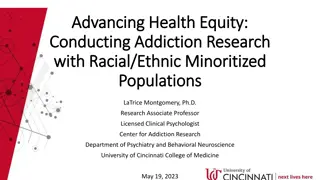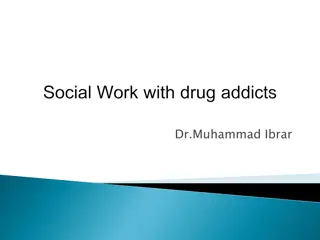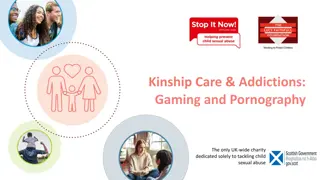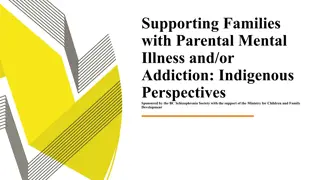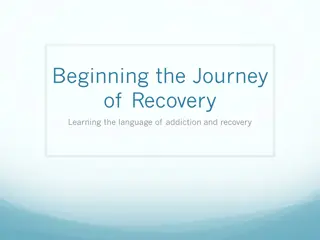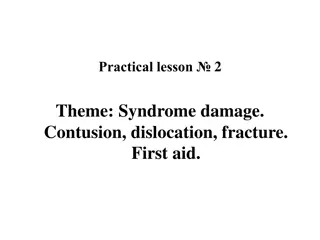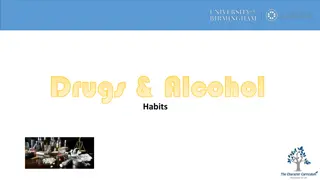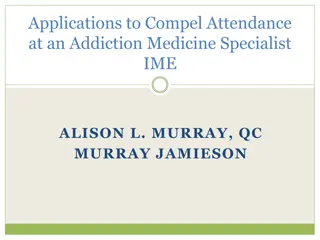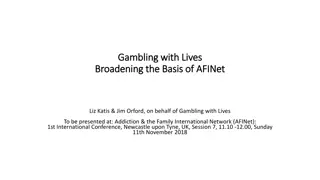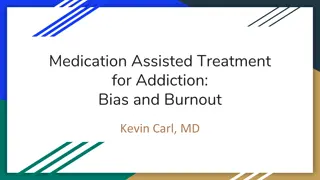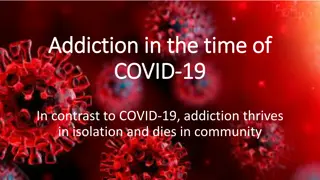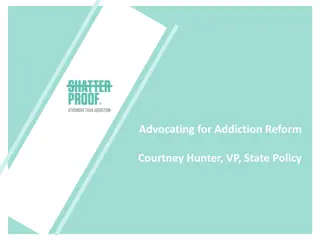The Impact of Dislocation on Addiction in Modern Society
Bruce Alexander's central idea in his article is that the root cause of today's addiction epidemic lies in the dislocation of entire populations from their communities and culture in a globalizing, post-modern society. Thomas Szasz challenges the concept of drug addiction, stating it is a matter of moral attitude and political strategy. Stanton Peele explains that overdosing on heroin can occur due to various factors. The Sacred Smoke program tackles drug addiction in communities. The content also discusses the development of black markets due to government intervention in the drug trade.
Download Presentation

Please find below an Image/Link to download the presentation.
The content on the website is provided AS IS for your information and personal use only. It may not be sold, licensed, or shared on other websites without obtaining consent from the author.If you encounter any issues during the download, it is possible that the publisher has removed the file from their server.
You are allowed to download the files provided on this website for personal or commercial use, subject to the condition that they are used lawfully. All files are the property of their respective owners.
The content on the website is provided AS IS for your information and personal use only. It may not be sold, licensed, or shared on other websites without obtaining consent from the author.
E N D
Presentation Transcript
1. What the central idea of Bruce Alexander article is? 2. How does Thomas Szasz see America s war against drugs? 3. According to Stanton Peele, why to people overdose on heroin? 4. What drug does the Sacred Smoke program tackle?
Thomas Szasz Bruce Alexander Dislocation Stanton Peele Rat Park RW
Alexander - Rat Park Dislocation Theory the source of today s flood of addiction lies in the dislocation of entire populations of people from their communities and culture in gloablizing, post-modern society.
Thomas Szasz there is, in fact, no such thing as "drug addiction." To be sure, some people do take drugs that the authorities do not want them to take; and some people do become used to taking certain substances, or become habituated to them; and the various substances which people take may be legal or illegal, relatively harmless or quite harmful. But the difference between someone "using a drug" and his being "addicted" to it is not a matter of fact, but a matter of our moral attitude and political strategy toward him.'
Ceremonial Chemistry At its most basic level this book is an examination of the social process of identifying deviant elements in society and "scapegoating" them. In ancient times the values used to identify deviants were religious in nature, but Szasz contends that scientific values have come to replace those of the bankrupt religious world-view. Szasz attacks the use of scientific positivism to identify deviants, and both the medical and legal professions are on the receiving end of his vituperous polemics; the former for being among the chief promoters of this phenomenon, and the latter for legitimating it and not protecting the individual from the resulting government encroachment. The law's unquestioning acceptance of positivism and its medical progeny is exemplified by statutory schemes that are ultimately based upon the medical model of "mental illness" and/or "competency."' Characteristic features of such legislation are provisions for involuntary civil commitment 5 and nonconsensual treatment.' While such paternalistic laws are intended to help those who are subjected to their application, Dr. Szasz has consistently maintained that their inevitable effect is an erosion of personal autonomy, and a mechanical non-humanistic conception of mankind.
Black markets develop to supply the illegal drug. Because the supply has been artificially reduced by government intervention into the marketplace, selling the drug becomes a high risk profession, the price becomes exorbitant. The addict may find that crimes against property and persons are the most convenient way of obtaining the money needed to pay the resulting inflated prices. Because the drug is not manufactured and distributed with the same quality controls that prescription drugs are, the product is adulterated and of variable strength. This is one major source of the drug related health problems.
Stanton Peele - Addiction is an experience, Peele asserts, not an invariant biochemical reaction. In his first chapter he sets forth evidence that conventional notions of addiction do not adequately explain the highly variegated reality they purport to address, including striking cultural differences in susceptibility to addiction to drugs and other experiences, nonaddictive use of the substances considered most addictive (e.g., controlled narcotic users, hospital patients given morphine), surprisingly common examples of natural remission (e.g. Vietnam veterans), and large fluctuations in individuals' usage patterns across the life span, even among heavy users. To recognize that addiction is akin to other complex human experiences is to bring to bear an individual's whole cultural background and social and psychological universe to understand the individual's reaction to a substance, sensation, or other compelling involvement. According to Peele, the experience of craving or of withdrawal, as well as of tolerance for a drug "engages a person's expectations, values, and self-concept, as well as the person's sense of alternative opportunities for gratification" (p. 2). This is the radical insight (developed both theoretically and empirically) that he has contributed to the field namely, that the observed physical and emotional manifestations of addiction (its defining attributes) are fundamentally influenced by psychological, environmental, and existential variables. Thus the word "interpretation" in the book's subtitle refers, in its narrower sense, to the way people interpret potentially seductive experiences (i.e., experiences on which some people, at some times and places, get "hooked") in the light of both their immediate circumstances and life histories. "Interpretation" has a broader application as well, which gives the chapter on "Theories of Addiction" an importance beyond its demonstration of the inadequacy of theories that pass as scientific, including both genetic and exposure (biological or conditioning) theories. Ideas do not exist on a sterile field: forged in cultural history, they reflect and shape individual experience. What we think has a lot to do with how we feel and act. Specifically, explaining and theorizing about addiction are not just scholarly pastimes. Rather, interpretations of addiction collective as well as individual are part of the causal nexus that surrounds the behavior. Researchers, clinicians, the legal system, the media, and the schools all contribute to causing or preventing addiction, to making it worse or alleviating it, by what they believe and say about it.
It is Peele's conviction that the United States, as much as any country in the world, has adopted a set of beliefs that make becoming and remaining addicted a self-fulfilling prophecy. As a result, millions of people have come to think they have a "chronic, relapsing disease" rather than a learned and culturally and situationally reinforced behavior that they can outgrow. In this way, Peele has taken the beleaguered term "addiction" a word so argued over and picked apart that many have discarded it and shown that it can have relevant and useful meaning. But the "meaning" of his title is a complex one, encompassing both the meanings individuals and cultures assign to their compulsive behaviors and the meanings we, as scientific observers, can find in those behaviors.
Robert West - Acquired need theories Addiction involves the development of physiological or psychological needs, as a result of engaging in the addictive behaviour, which are then met by the addictive behaviour. Drug withdrawal theory This is probably the most commonly held theory of addiction. Under this theory, physiological adaptation occurs with the presence of a drug in the body so that, when the drug is no longer present, physiological rebound occurs, leading to unpleasant and sometimes life-threatening symptoms
Pre-existing need theories Addiction involves engaging in behaviours that meet important pre-existing needs. A striking observation in those people who are addicted to illicit drugs is the proportion who suffered abuse as children (Simpson and Miller, 2002). There is also good evidence of a strong association between depression and anxiety in children and subsequent development of addiction to a range of drugs including alcohol and nicotine (Douglas et al., 2010). This, together with self-reports of addicts, has led to the view that an important motive for taking up and continuing with an addictive behaviour pattern is to meet pre-existing psychological needs. The need may involve numbing or improving adverse mood. In the case of smoking, it has been suggested that one reason that people with schizophrenia smoke is to help with gating of sensory inputs, which is an important factor underlying the symptoms of this condition (Adler et al., 1993, 1998). In all these cases, the presumption is that these needs contribute to the process of reflective choice, which may or may not be rational.
Self-medication theory Addicts have pre-existing psychological problems arising out of early life experiences, genetic endowment or an interaction between the two, and the addictive activity provides relief from the aversive experiences arising from these. This may be by way of numbing of affect, reduction in negative affect, distraction or countervailing positive affect (Khantzian, 1997). Attachment theory As applied to addiction, attachment theory proposes that addiction represents a misguided attempt at self-repair arising from maladaptive attachment styles, which in turn arise from developmental problems and environmental deprivation. Substance use exacerbates the problem because of the physical dependence and damage to psychological structures (Flores, 2004). Affect regulation theory In its general form, this theory proposes that addictive behaviours, and in particular substance use, arise out of defective affect regulation systems. This means that, on the one hand, individuals may be vulnerable to seeking out an addictive behaviour in the hope that it might help overcome this problem, but, on the other hand, they may be vulnerable to continuing with the addictive behaviour because the behaviour exacerbates the problem, leading to a vicious circle (Cooper et al., 1995).
Identity theories Addiction arises from, and is at least partly maintained, by aspects of one s self-identity (how one views oneself). A different kind of theory from those above focuses on the importance of identity as a source of motivation. Under these theories, one s self-concept, often deriving from people with whom one identifies, shapes one s behaviour. There are important theories of behaviour that involve aspects of identity, most notably social cognitive theory (Bandura, 1977) and the theory of planned behaviour (Ajzen, 1991), in which one s perception of one s self-efficacy or ability to control one s behaviour plays an important role.
DRUG USE BY U.S. ARMY ENLISTED MEN IN VIETNAM: A FOLLOW-UP ON THEIR RETURN HOME Abstract Between May and September 1972, 943 men who had returned to the United States from Vietnam in September 1971 as Army enlisted men were sought for interview and collection of urine specimens. Of these men, 470 represented the general population of Army enlisted men returning at that time; 495 represented those whose urines had been positive for opiates at time of departure from Vietnam. At interview 8 12 months after their return, 83% were civilians and 17% still in service. Nine hundred were personally interviewed and urine specimens collected for 876. Almost half of the general sample tried heroin or opium while in Vietnam and one-fifth developed physical or psychological dependence. In the 8- to 12-month period since their return, about 10% had some experience with opiates, but less than 1% had shown signs of opiate dependence. In the drug positive sample, three-quarters felt they had been addicted to narcotics in Vietnam. After return, one-third had some experience with opiates, but only 7% showed signs of dependence. Rather than giving up drugs altogether, many had shifted from heroin to amphetamines or barbiturates. Nevertheless, almost none expressed a desire for treatment. Pre-service use of drugs and extent of use in Vietnam were the strongest predictors of continued use after Vietnam. The results indicate that, contrary to conventional belief, the occasional use of narcotics without becoming addicted appears possible even for men who have previously been dependent on narcotics.




